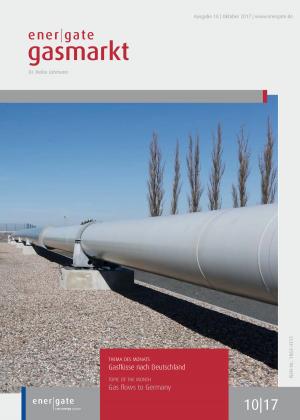Topic of the Month: Gas flows to Germany
“Exports from Russia are at record levels”, the Russian gas company Gazprom stated at the end of August. During the first eight months of 2017, Germany received a total of 12.8 per cent more gas from Russia than in the same period in 2016. Gas exports to Austria were up by 60 per cent. At the same time, the company announced that gas transit via Ukraine was increasing. What are the reasons? The Jamal-North pipeline is being fully utilised. Moreover, the capacity of the connecting pipeline to North Stream 1, OPAL could only be fully utilised by Gazprom since August this year (ener|gate Gasmarkt 09/17). Also, from September 11 to 22, Nord Stream 1 was interrupted due to annual maintenance. Therefore, Gazprom currently needs the Ukraine transit for the delivery of the high volumes.
On the other hand, Poland fears future problems for the Yamal utilisation. In the complaint against the full OPAL utilisation the Polish gas company, PGNiG argued that the Yamal North flows will be reduced in future and this will have an impact on the Polish network system. However, also “new” in the Eastern part of Europe (not so new anymore) are Ukrainian gas imports from the west, mainly from the Slovakian hub where the Ukrainian gas company Naftogaz takes most of the gas.
Market DevelopmentNCG system control energy
Since April 2016, NCG trades L-gas system control energy that is explicitly needed at the Ger- Fig. 10 : H-gas supply sources (Source: FNB Gas: Scenario framework for the NEP 2018 to 2028) Only for conversion freaks and those who want to become one Both market area operators published all data on conversion. NCG changed the way commercial conversion volumes are given. The daily cost for commercial conversion (H-gas into L-gas) is calculated as follows: All L-gas buys and all H-gas sells at the virtual trading point are summed up. The lower of the two sums is the conversion volume. For all purchases and sales, the volume-weighted average price is calculated. The difference between the two prices is the specific price for conversion. The conversion volume multiplied with this specific price is the daily conversion cost (for conversion from L-gas into H-gas, the whole game is played the other way round). In the past, NCG showed the conversion volume in its double magnitude, arguing that this volume was bought and sold. This was changed and hence the given volume and the specific price fit directly for calculating conversion cost. The cost itself remains, of course, unchanged. Box 1: Publication of commercial conversion volumes Issue 10|17 43 Market Development man-Dutch border points Vreden and Elten on the PEGAS platform. Last year, PEGAS launched the necessary special products with the local delivery points. NCG buys and sells single hours, sometimes tiny volumes of one MWh. The trading, market participants say, is automated. In particular for the buying of system control energy, frequently price spikes occur for single hours and NCG pays up to 200 euros/MWh



